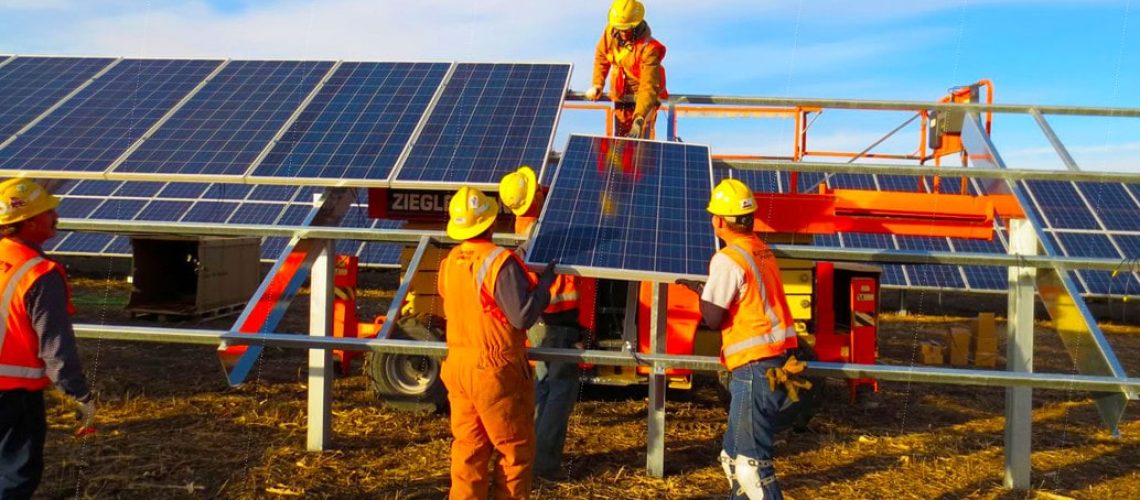The upward trajectory of the solar industry in the United States brings new challenges, not the least of which is building a workforce. The challenge is not just finding workers, but preparing workers for the clean energy transition, but the opportunities are many.
The growing clean energy economy offers excellent career opportunities for displaced workers from fossil fuel industries, such as from shuttered coal plants. It also offers some opportunity for traditionally under-represented populations. New workforce-related requirements were put into place by the Inflation Reduction Act (IRA) that aims to address training, pay, diversity and job development in underserved areas.
In the recent Intersolar webinar, Clean Energy Workforce Development, Bernice Diaz, labor & employment associate at Sheppard Mullin Richter & Hampton LLP shed light on prevailing wage and apprenticeship requirements added to the Internal Revenue Code, which she said has “substantially changed existing federal income tax benefits for renewable energy”.
Diaz explained that there is now a two-tiered system that provides a base credit equal to 20% of the maximum credit and an increased credit equal to an additional 80% that would be only available to taxpayers after certain prevailing wage and apprenticeship requirements are satisfied. In the past taxpayers were could receive the full amount of the tax credits without paying prevailing wage or employing the applicable number of apprentices.
Prevailing wage requirements are not new in the construction industry. As specified in the Davis Bacon Act, a federal law that stipulates that all laborers employed for the construction alteration or repair of certain federally funded or assisted contracts be paid the prevailing wage. Until now, clean energy projects did not have to abide by the Davis Bacon Act, but the IRA is effectively closing that loophole, according to Diaz, “by conditioning the majority of the tax credit on payment of prevailing wage and, and hiring a certain amount of apprenticeships.”
The guidance was published in the Federal Register on November 13, 2022, and projects that begin before January 29, 2023 are exempt from the requirements, Diaz noted. She added that “even without complying with those requirements, they’re able to take the full tax credit under the law”.
To satisfy the wage requirements, the taxpayer must not only pay the prevailing wage, but they must also “maintain and preserve sufficient records to substantiate that they did pay the prevailing wage rate,” said Diaz.
Prevailing wage differs by location, as it is determined by the Department of Labor Wage and Hour Division, which does surveys on local wages paid to laborers and mechanics in different areas across the country.
Apprenticeship
To meet apprenticeship requirements, taxpayers must ensure that, for construction that begins before January 1, 2023, at least 10% of labor is performed by qualified apprentices. This steps up to 12.5% for construction that begins after December 31, 2022, and before January 1, 2024. And then bumps up again to 15% for construction that begins after December 31, 2023. A taxpayer will be deemed to have met the requirement if the employer contacted a registered apprenticeship program for workers and the programe failed to respond within five business days.
California, which long has had one of the largest, solar markets in the country, has a growing need for a clean energy workforce. The need is further escalated by the state’s goal to be carbon neutral by 2045. Tyson Eckerle, senior advisor for clean infrastructure and mobility for Governor’s Office of Business and Economic Development, discussed on the webinar ways in which his office is supporting quality jobs and equity.
With a budget of $2.1 billion, his office focuses on jobs that combat climate change, assist, justice involved population and create opportunities to recruit, hire, train, in advance, ethnically and culturally inclusive workforce. “Our strategies include apprenticeship and hybrid training, partnerships and other earn to learn things,” he said.
With the giant caveat in the apprenticeship requirement that employers are exempt if they haven’t heard back from a program, the California Office of Business and Econonic Development wants to make sure that that doesn’t happen. “We’re trying to make sure that there is when a company does reach out for apprenticeships and apprentices that those apprentices are there, they’ve been trained, they’re ready, they’re ready to go,”,according to Eckerle.
Part of the agency’s strategy is to bring together major stakeholder groups to try to solve the problems today, Eckerle said, noting that there are really four pillars of the market: vehicles, infrastructure, users and workforce. “If we’re short on workforce, we won’t have the infrastructure needed to enable the vehicles and end users to be successful,” he said, adding that, “Our labor agency is laser focused on making sure that we are creating the job training and opportunities and connecting those opportunities to the market.”
Apprenticeship programs are popping up across the country, rising up to meet the projected need for workers. Another webinar panelist, Jeffrey Clary, senior director of climate strategies at the Foundation for California Community Colleges spoke about how partnerships with community can be a catalyst for clean energy workforce development. For example, solar developer Sunation recently partnered with the Suffolk County Community College in New York to train a clean energy workforce on Long Island. Its inaugural class started in the fall semester of 2022, working toward completion of the solar installer Certificate Program that features an entry-level solar curriculum coupled with a paid externship and job interview process upon graduation of the 50-hour program.
“Community colleges really are some of the foundations of professional training in this nation,” Clary said. He noted that there are about 1100 community colleges in the country; 116 of which are in California, making up a total of 1.8 million students. Combined, he said it’s the largest higher education institution in United States, possibly in the world. One key difference between community colleges and other instututions of higher learning is that community colleges accept all applicants. “We work with everybody and help them get on their professional track to get where they want to go,” said Clary.
Clean energy training through community colleges has a number of advantages, according to Clary. They’re one of the biggest pools for a potential workforce. They are training students who live in the communities where they will work. They also tend to be locally governed, Clary said, making them able to respond to regional economic conditions. There are also mechanisms in place for partnerships with companies that are in need of trained workers.
Implementation
Many questions remain about the apprenticeship requirements, and Diaz acknowledged that additional guidance is needed on many fronts. For example, questions remain about the “good faith exemption” for companies that have unsuccessfully reached out to an apprenticeship program. There are also questions about what determines whether an apprenticeship program is “registered.” Diaz said that state programs are supposed to be approved by the Department of Labor under the Fitzgerald Act, but would an employer receive credit if a program is not registered? And, last but not least, the big looming question is whether there will be enough people seeking training in order to join the clean energy workforce. With a trend away from skilled labor jobs, a new challenge emerges.






